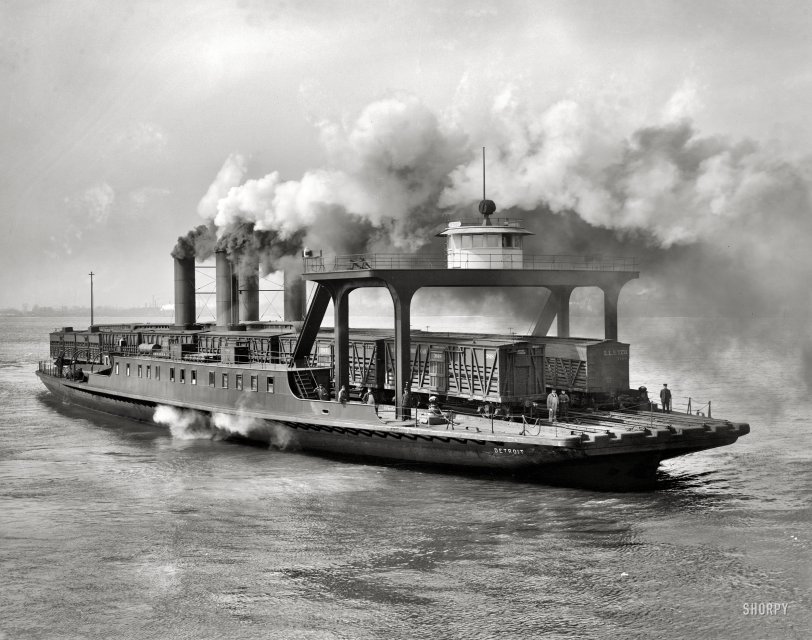


Framed or unframed, desk size to sofa size, printed by us in Arizona and Alabama since 2007. Explore now.
Shorpy is funded by you. Patreon contributors get an ad-free experience.
Learn more.

- Indiana Harbor Belt abides
- Freezing haze
- Corrections (for those who care)
- C&NW at Nelson
- Fallen Flags
- A dangerous job made worse
- Water Stop
- Passenger trains have right of way over freights?
- Coal
- Never ceases to amaze me.
- Still chuggin' (in model form)
- Great shot
- Westerly Breeze
- For the men, a trapeze
- Tickled
- Sense of loneliness ...
- 2 cents
- Charm City
- What an Outrage
- Brighton Park
- Catenary Supports
- Just a Little Before I was Born
- Afternoon normal
- The Flat Iron Cafe survives
- Aging in Place
- Raise your hand
- Good and Bad
- Oh, the 70's
- Nooooooi
- The aluminum tubing
Print Emporium
Smoke on the Water: 1905

The Detroit River circa 1905. "Transfer steamer Detroit." Yet another view of this workhorse of the waterways. Detroit Publishing glass negative. View full size.
Smoke on the Waters, 1905
This ship was still running well into the 1980s and perhaps beyond. My son Eric and I rode the engine room in 1971. A fascinating voyage. Two large single cylinder engines drove the props. If they stopped at the end of a stroke, the engineer had a steel pry pole to push them off Top Dead Center. This ship and it's running mate the Lansdowne, were the two oldest ships on the lakes, thanks to their Iron Hulls. The Lansdowne was a paddle wheeler & was the winter boat. built in 1885, with engines salvaged from a wooden car Ferry built in 1875. When one wheel shaft broke about 1972, the local crew sent an indignant letter to the CNR Pointe St Charles Shops saying there was something wrong with a piece of machinery that only lasted 97 years. The Lansdowne became a posh restaurant for several years tied up beside Cobo Hall in Detroit, but went bankrupt. The last I heard The Detroit was still carrying freight cars as a barge.
Revisionist history
Taking a closer look, only the nearest car with a clerestory roof seems large enough to be a passenger car for these times. It may well be a baggage/mail storage car instead. The other two similar cars appear to be quite a bit shorter and therefore are more likely to be mail storage or postal/mail storage cars.
The window configuration would tell us what these cars were, so I walked around my monitor to look at the other side of the ship but all I could see was "Made in Korea."
Passenger Cars
Trains with many stock cars included some accommodation for the workers who fed and watered the animals when needed. Although three passenger cars seems like a lot, there could easily have been many more stock cars so perhaps that's why there were three cars.
Passenger cars
If you look in the back; there are the clerestory windows of several passenger cars. I believe that these are probably Michigan Central cars.
Passengers
There are three likely passenger cars on the center track, as can be seen by the clerestory roofs. If there were people on board the smell of livestock on either side must have been pungent.
Passenger cars
You can just see the clerestory roofs of passenger cars on the far track. These cars could be regular coaches or accommodation for drovers riding with the livestock train. They could also be express or mail cars.
Variety of patented stock cars
If you look closely you can see there are several different kinds/designs of stock cars. A lot of these were patented and owned/operated by companies such as Canda and Mather. The right front car is a Mather patent car from the Mather Stock Car Company. The next two cars are a different Mather patent. The ones on the far left with the little box on top of the roof might be a Canda patent. The various mechanisms (the roof box on the left cars, the rods you can see on the cars in the middle) are used to load feed (hay, etc). Often stock cars had a lot of staining along the floors from the 'bovine residue' and the lime used to clean same. These cars look new/very well maintained. They also all have air brakes and grabirons/ladders mandated by the Safety Appliances Act, which were mandatory the following year.
The "L.L.S.T.Co" car has an unusual truck design, which I don't recognize.
John White's book "American Railroad Freight Car" has a great discussion on stock cars and the various patented designs from this period.
The Adage
A picture is worth a thousand words. This is the best description I've ever seen for the nautical term "Captain's Bridge."
Not called a steamer for nothing
Though "smoker" might be more appropriate in this case.
Could they have imagined?
In just 106 years, huge container ships with thousands of stacked semi-trailers full of novelty items from China (fake vomit, whoopee cushions and ersatz dog doo included) would be zipping across the ocean at unforeseen speeds to deliver their treasures to unemployed Americans. No, I can't figure it out either.
Cattle cars
Looks like the Detroit was carrying a load of livestock cars. I wonder it they were full or empty. Looking at car #3818 I would say empty.
Did these Transfer steamers carry passengers as well as rail cars?
























On Shorpy:
Today’s Top 5